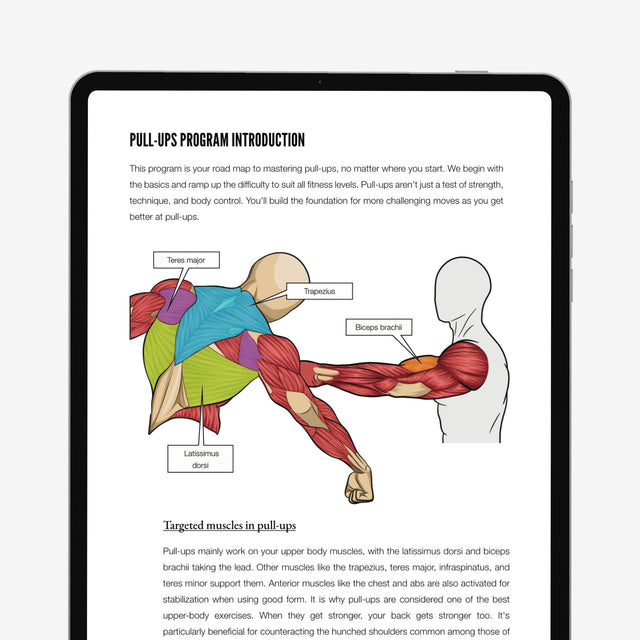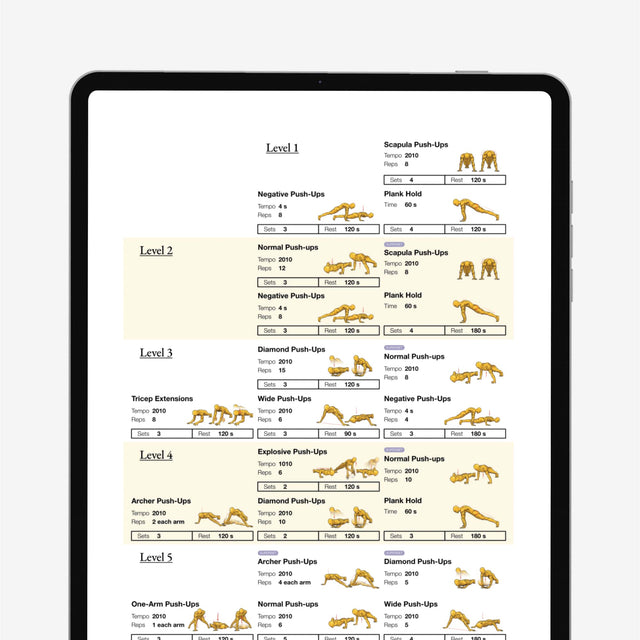Should I do calisthenics every day? - Here’s How to Make it Work For You
Whether you should or shouldn’t do calisthenics daily is dependent on your goals and preferences. You certainly can train calisthenics every day, if you focus on one area in each session. While having proper rest and recovery measures to support your routine.
So to decide whether you should do calisthenics every day, as always, depends on your preferences. There are a thousand ways to get fitter, and calisthenics is simply one of them. And within calisthenics there are hundreds of ways to do that too!
Is it safe to do calisthenics every day?
Each muscle group you train needs at least forty-eight hours of rest to properly recover, before being hit again. If you properly spread out your training with this in mind. You can safely practice calisthenics every day.
It’s when you do a full body workout that things tend to go wrong. While training full body in a session is viable, giving you more endurance and muscle tone. It’s not optimal for maximum muscle growth and calisthenics skill development.
Doing full body workouts every single day is something bodybuilders on gear might be able to pull off. They’d have to maintain a minimum five hundred caloric surplus, ten hours sleep, and many other recovery practices such as long massages and sauna → ice bath cycles.
If you’re training at maximum intensity, for every part of your body, in one session. Not only would that take hours, but you’d sacrifice gains for each muscle as you’re recovering all of them at once. Spreading your bodies resources thin.
How many days a week should I do calisthenics?
You should train every day, but that’s merely what I think. Others have seen results training three days a week, two times a day, five days a week, or every single day. It’s all about how you structure your training.
The only factor that determines how many days a week you should train calisthenics is recovery - how much time are you giving each muscle to recover? You need at least forty-eight hours rest per muscle group. If less than that, you will have diminishing returns.
So taking that into account, you could train every day, three times a week, every other day, or whatever combination you come up with. It’s about spreading exercises out so you have time before doing it again.
Can I do calisthenics twice a day?
You can, but it depends on what workout you’re doing. If you’re doing push ups & dips in the morning, then diamond push ups & pike push ups in the evening. Then that would be fine, as you’re primarily hitting the “push” muscle groups.
Hitting one muscle group per day would be the best way to train twice a day. Here’s an example schedule of training calisthenics twice a day:
|
DAY 1 |
Morning: Pull ups & Chin ups Evening: Wide pull ups & Scapula pull ups |
|
DAY 2 |
Morning: Squats & Lunges Evening: Lateral lunges & Calf raises |
|
DAY 3 |
Morning: Hanging knee raises & Captain chairs Evening: Hollow body hold & Plank |
|
DAY 4 |
Morning: Push ups & Dips Evening: Diamond push ups & Hindu push ups |
|
REPEAT |
|
Can you do calisthenics 2 days in a row?
Yes, you can train calisthenics two days in a row and every day if you wanted. It’s down to how to program your routine. As I’ve said, forty-eight hours rest for each muscle group is ideal.
So if you spread out your routine so each muscle group you target has time to rest. Then you can do calisthenics two days in a row, three days in a row, etc. Until you’re absolutely jacked doing muscle ups like you weigh a feather.
Is calisthenics 3 days a week good?
You can train calisthenics every day or three days a week. But you shouldn’t really train every day if you do intense full body workouts. It’s much better to do three times a week in that case, like so:
|
Monday |
FULL BODY |
|
Tuesday |
Rest |
|
Wednesday |
FULL BODY |
|
Thursday |
Rest |
|
Friday |
FULL BODY |
|
Saturday |
Rest |
|
Sunday |
Rest |
With more common workout splits like PUSH, PULL, CORE, LEGS. Then you can train every day, as there is more room to recover fully for each muscle group. Let’s say you used this example calisthenics workout:
|
DAY 1 |
PUSH |
|
DAY 2 |
PULL |
|
DAY 3 |
CORE |
|
DAY 4 |
LEGS |
|
REPEAT |
|
In this example, you could train chest on a Monday, and do it again on Friday. This would mean your chest had Tuesday, Wednesday, and Thursday to recover. If you apply this way of spreading out your exercises, then you can easily manage training every day.
Do you need rest days from calisthenics?
At a basic level of recovery, give each muscle at least two days to rest before being hit again. Doing this you can maximise your recovery for each area. With rest days, you can play it by ear and take a day off every so often. If you do this, why not use the extra time to boost recovery?
5 ways to maximise recovery
1 - Optimise sleep
Sleep is where the majority of your bodies recovery happens. Your brain goes through various states of sleep such as REM, alpha state, and delta brain wave patterns. Various bodily functions help repair bone cells, skin cells, and as far as we care; muscle tissue.
Ten hours of sleep is the absolute best amount you can get before diminishing returns. Get as close to this as you can, we are all busy, so you might want to do seven to nine hours of sleep instead. This is aimed for adults, as sleep requirements vary throughout age groups.
The technicalities of sleep are numerous, but there are a few things you can do to make sure you make the most out of it:
- Sleep at 21:00 (9PM). According to chronobiology, your body starts melatonin secretion at 9PM. Your bodies hormonal system cycles throughout a 24-hour period. So staying in tune with yourself helps maintain hormonal balance.
- Train hard in your workouts. Being fatigued from intense physical activity means your body has more recovery work to do. So it uses more energy, and you’ll naturally be more tired and fall asleep easier.
- Be as strict as you can with your sleep schedule. If your sleep pattern is all over the place, then your circadian rhythm will be out of whack. Sleeping and waking at the same time every day trains your body to be in sync.
- Sleep in complete darkness. Light hitting your skin can wake you up. And blue light entering your eyes inhibits melatonin production.
- Have as quiet a room as you can. Although there is evidence that using slow-wave sleep (SWS) brain-wave music, reduces time it takes to fall asleep, and improve the quality of sleep. It’s best to minimise the sound coming into your sleeping area.
- Don’t eat too much before 09:00 and don’t eat after that. Being bloated can easily cause you to stay awake and uncomfortable in bed. Eating during sacred sleeping time can also damage your organs long term.
2 - Short naps
Ten-minute power naps aren’t just some elderly thing to do. They help:
- Boost alertness
- Enhance mood
- Increase your performance mentally and physically
- Support memory
- and increase your creativity
People who do creative jobs use them right before their work sessions. Triggering some extra connections in their brain for cool ideas.
With calisthenics recovery, the quick recharge can help you kickstart the healing process and help balance your hormones. Which so many people neglect. Hormones are like all the regiments of an army that your body uses to operate.
Including recovery.
Some people have even said they take short naps before their Muay Thai training. So fit these in where you can, even if you’re just lying on your office floor.
3 - Stretching
Stretching for ten to thirty minutes a day, especially in the morning after drinking warm lemon water, can massively boost your recovery. The lactic acid build up in your muscles is broken down and released, so the healing process can have maximum effect.
30–60 seconds per stretch is ideal. You want to give the muscle enough time to be fully wrung out like a towel, and release lactic acid.
Massage therapists often recommend this after giving a full body message, “drink plenty of water and take the day off”. Of course, we don’t always take the day off and go train anyway. But doing this extra bit makes all the difference in an intense training regime.
As well as stretching you want to warm up with a few simple moves before and after a workout. Doesn’t have to take long, could be two to five minutes of simple band exercises. Or arm swings before pull ups, for example.
4 - Sauna + Ice bath cycles
Getting in a sauna for three to five minutes, then going straight into an ice bath for one or two minutes. And repeating this three to five times in a row massively boosts recovery. It cleanses your body of excess oils, literal “muscle stress”, and also helps deal with lactic acid.
Now not all of us have access to this, so the next best thing is to have the hottest shower you can manage. Then the coldest your shower will go. Then do that three to five times just like I said.
5 - Hydrate
Drink two to three litres of water daily, sometimes four, or even five - if you do a lot of sport or cardio. Water is the building block of life, and if you don’t get enough, your body won’t be able to function properly.
Things that make water even better is by adding essential minerals. Some natural Himalayan salt can serve as a fantastic electrolyte. But the best electrolyte is Quinton Plasma, as it somehow makes the water structure more “organic”, so your body accepts it more effectively.
Generally, it’s best to have your water as pure as possible. Getting yourself reverse osmosis filters, or water swirlers, can help cleanse and increase the hydration you get from drinking.
6 - Caloric surplus
Getting enough energy in with calories is what makes your body able to grow muscle, repair, and replace cells. In your workout routine you’re breaking down muscle tissue, and replacing it with new stronger ones. This, of course, requires energy to do so.
There are many online tools for calculating your maintenance calories. Find your maintenance, then eat above that. To make sure you recover as much as possible.
For bulking and building muscle, two hundred to three hundred calories above maintenance is a healthy number to maintain.
7 - Using specialised equipment
Gymnastic rings, for example, are fantastic for your joint health.
Doing pull ups on straight bars is effective, however if you actually train hard, after a while you can develop joint problems. You can reduce these problems with proper form or alternative exercises. But the unnatural movement pattern of pulling up, without your hands rotating at all, can lead to additional stress on your joints.
So what gymnastic rings do, is they allow for rotation throughout the movements you do on them. So your joints are in positions that don’t compromise anything. And you can focus more on the intensity of your workout, knowing you’re doing the best variation of that exercise.
There are other pieces of gear such as foam rollers. Which you can use to massage certain areas, and do similar things a massage therapist can achieve.
Other equipment such as parallettes help support your wrists. As they’re in a more natural gripping position throughout pushing movements. Which you can also achieve with gymnastic rings.
How to train calisthenics every day
If we’re training every day, you want to take into account your level. Beginners that go from zero to calisthenics hero may experience delayed onset muscle soreness. This is where you push too hard too soon into your bodyweight training, before your muscles have time to adjust.
All delayed onset muscle soreness means is just your body adjusting to the additional lactic acid created from working out regularly. It’s not really something you need to worry about if you choose exercises you can manage, and incorporate stretching into your day.
Now, when it comes to your nutrition, it’s important to cut out all the crap, and stick to natural foods. Choose everything that is in its natural raw state where you can, like getting steak from the butchers - right off the bone. Or picking out vegetables from your local farmer’s market.
With balancing your macronutrients in your nutrition, you want to have some bias towards carbs. As they give you the most energy. Dietary requirements range from person to person, but you want something like:
- 15-30% protein
- 50-65% carbs
- 15-25% fat
This is just an example, and you should do your own research before choosing your macros.
Hope this gave you the insight you were looking for, if not, please feel free to join our Gravgear telegram group for help from those in the community.









